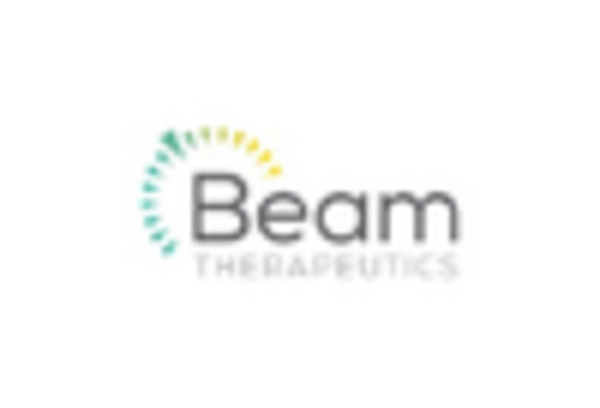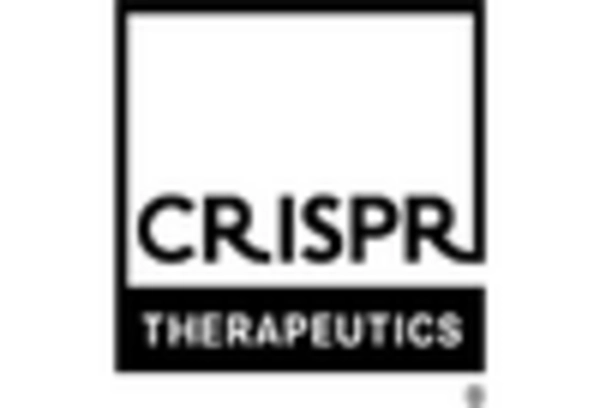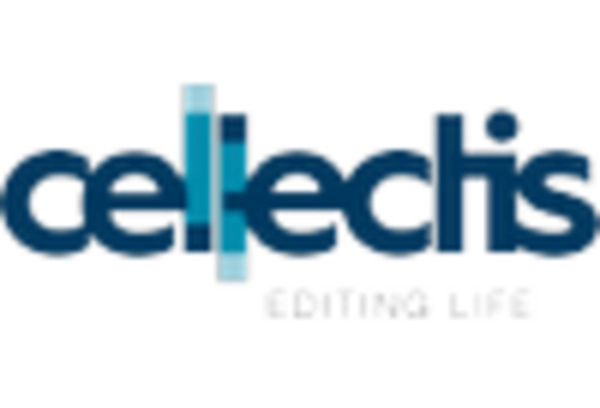Rising Incidence of Genetic Disorders
The Base Editing Market is witnessing growth due to the rising incidence of genetic disorders worldwide. Conditions such as sickle cell disease, cystic fibrosis, and muscular dystrophy are becoming more prevalent, necessitating the development of effective treatment options. Base editing offers a promising solution by allowing for precise corrections of genetic mutations at the base level. According to recent estimates, approximately 1 in 10 individuals are affected by genetic disorders, highlighting the urgent need for innovative therapies. This increasing burden of genetic diseases is likely to drive investment and research in the Base Editing Market, as stakeholders seek to address these critical health challenges.
Increased Funding for Genetic Research
The Base Editing Market is experiencing a boost from increased funding for genetic research initiatives. Governments and private investors are recognizing the potential of gene editing technologies to address pressing health issues. Funding for research in base editing has seen a significant rise, with investments reaching over USD 5 billion in recent years. This influx of capital is enabling researchers to explore new applications and refine existing techniques, thereby enhancing the capabilities of the Base Editing Market. As funding continues to grow, it is expected that the pace of innovation will accelerate, leading to the development of novel therapies and applications in the field of genetic editing.
Increasing Demand for Precision Medicine
The Base Editing Market is experiencing a notable surge in demand for precision medicine, which emphasizes tailored treatments based on individual genetic profiles. This trend is driven by advancements in genomics and biotechnology, allowing for more effective and personalized therapies. As healthcare systems increasingly adopt precision medicine approaches, the need for innovative gene-editing technologies, such as base editing, becomes paramount. The market for precision medicine is projected to reach USD 100 billion by 2025, indicating a robust growth trajectory. This demand is likely to propel the Base Editing Market forward, as researchers and clinicians seek to leverage base editing techniques to develop targeted therapies for various genetic disorders.
Advancements in Gene Editing Technologies
The Base Editing Market is significantly influenced by rapid advancements in gene editing technologies. Innovations such as CRISPR and other genome editing tools have revolutionized the field, enabling researchers to make precise modifications to DNA sequences. These advancements enhance the efficiency and accuracy of gene editing, making it a preferred choice for researchers. The Base Editing is expected to grow at a CAGR of 15% from 2023 to 2030, reflecting the increasing adoption of these technologies. As base editing continues to evolve, it is likely to play a crucial role in the development of novel therapies, thereby driving growth in the Base Editing Market.
Collaborations and Partnerships in Biotechnology
The Base Editing Market is benefiting from a growing trend of collaborations and partnerships among biotechnology firms, academic institutions, and research organizations. These alliances facilitate the sharing of knowledge, resources, and technologies, accelerating the development of base editing applications. For instance, partnerships between biotech companies and universities have led to breakthroughs in gene editing research, enhancing the overall capabilities of the Base Editing Market. The collaborative nature of the industry is expected to foster innovation and expedite the commercialization of base editing technologies, thereby contributing to market growth. As more entities recognize the potential of base editing, the number of strategic partnerships is likely to increase.


















Leave a Comment